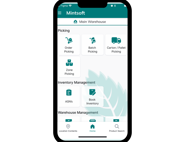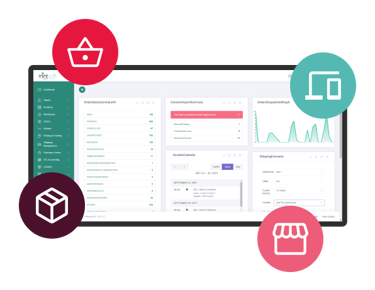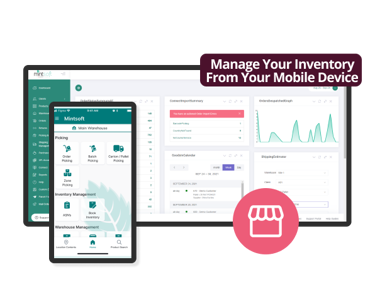Your Guide To Inventory Management
Our comprehensive overview of Inventory Management, what it is, why it's important and how it can help your business become more efficient.
What is inventory management?
Inventory management is the process of monitoring and administering the stock held by a business for the purposes of maximizing efficiency, ensuring a high quality of service and reducing associated costs. This primarily focuses on the buying, receiving, and storing of goods. more specifically, inventory management also includes managing the cost, quality, and quantity of inventories and is also referred to as stock control.
This process in general is concerned with monitoring goods - certainly finished goods but also possibly raw materials and components from one end of the supply chain to the other - ensuring that you have enough stock on hand to fulfil customer orders and that you do not have to pay over the odds for items that you become in desperate need of. It can also help you know exactly when to order more and minimize the number of excess stock items that may be occupying valuable space in your warehouse.
Types of inventory
There are many types of inventory, but which ones your company will deal with will depend on the types of products you sell. The most likely ones you will encounter are:
Finished/for sale goods
The products for sale to your customers.
MRO goods
Maintenance repair and operating goods are the inventory you maintain to support the manufacturing process.
Safety Stock
The excess inventory you keep and maintain in order to deal with supplier shortages or demand surges. Additionally, in a manufacturing concern you might also expect to see:
Raw Materials
The stock you use to make finished goods.
Work-in-progress
In essence, the unfinished goods that are partway through the manufacturing process.



What features does a good inventory management system have?
Inventory management software helps track the inventory in a company or a supply chain. The software does this by monitoring stock level and sales data for each item in an inventory. It also helps to automate the process of adding new items to inventory, tracking sales, and updating stock levels.
An efficient inventory management software would have adaptable features. These features should include barcoding and tagging, inventory tracking, real-time updates, integrations in to your existing technology stack, inventory forecasting, alerts, security, backups and multiple automations such as re-ordering and PO creation.
Inventories are the backbone of most E-commerce businesses. In order for a company to be successful, it needs to know what inventory they have and how much they will need in the future. In the modern age, inventory software should also provide data. Analysts need a system that will collect and report inventory data that they can then use to make data-driven business decisions.
Good inventory management systems are essential for efficient inventory control. They help you keep track of all your stock to avoid any stock-outs or shortages. One of the most important features of an inventory management system is its ability to plan purchases and sales in advance. This will help avoid overstocking or under-ordering. Lots of businesses have large inventories, so it can be difficult to keep track of everything manually.

How do inventory management systems work?
Inventories are managed using a computerized supply chain management system. Inventories are recorded in a database, with different users having different access rights. When a product is sold, the inventory management system automatically records the product as sold and removes it from the system. When a product is received, it is automatically recorded as a new item and added to the inventory software. The inventory tracking system is integrated with the rest of the software systems of the company, such as reconciling the accounting software- e.g., QuickBooks Ecommerce program. When an employee scans an item using a barcode scanner, the system will update the inventory database with the new information.
The system handles purchase orders, storage of goods, and delivery of goods to customers. It is also possible with some to monitor the pricing of products on the market, so that your company gets the best deals available at any given moment.

Common features of an inventory management system
Why would you need inventory management systems?
Inventory management is a process used by all kinds of companies, from small business retail operations to wholesale distribution and manufacturing outfits to service and manage their stock. In short, it is a system used to track the quantity of a product in a company's possession. This inventory data is then used to make decisions such as whether or not to reorder from a supplier, how much to charge or pay, and become aware of stock that is in danger of perishing or becoming obsolete.
In a manufacturing or services industry, inventory levels may be tracked to ensure production times are not impacted by a lack of raw materials. In a retail setting, inventory is tracked to ensure that the shelves are fully stocked, with the right amount to meet demand. Not too little to avoid disappointing customers, but not so much as to waste warehousing space - both of which serve to maximize profits.
Inventory management systems are not just about eliminating the use of paper, but by going paperless a track record can be more easily located, stored, queried and insights gleaned. With cloud-based inventory management software, one need not even be in the office - a mobile phone and a data connection allow you to log in to the system at any time, with no need for the user to concern themselves with updates, downloads or installations.

Benefits of an inventory management system
Run your business smoothly
Inventory software will allow you to store excess stock and inventory, including materials used in the production process. Smaller businesses would usually do stock inventory manually which can disrupt the process as well as being time-consuming, Inventory management systems would reduce or entirely remove the need for manual stock checks and would also provide more accurate figures than a manual inventory check.
Keep customers happy
Inventory management systems dictate the speed at which inventory and products get to your customers, how reliably you can consistently fulfill a customer sales order, and allow your customers more visibility into your process - increasing trust levels between customer and company. Customers will have a much higher rate of satisfaction if they can reliably count on your organization to deliver an order in a timely manner - especially if they are updated as to its availability and progress along its fulfilment journey. This is especially true in terms of business-to-business relationships. For retail consumers a missed deadline can be inconvenient but for business, it can mean lost profits and missed sales.
Grow your business
When a business grows in size and complexity, the need for a more complex system to manage it is also increased. When new product lines, staff, and production lines are required because of growing customer demand, the organization of those stocks and materials becomes harder to manage. It is important to get control over physical inventory from the get-go if you plan to upscale your business. Rapid growth can create a lot of work, including hiring staff, moving to bigger, multiple locations, and making new negotiations with suppliers. Having an efficient stock/inventory system in place early on will help eliminate a lot of growing pains by scaling effortlessly alongside you.
Save time with automation
By automating tasks such as purchase order creation, the efficiency of the operation is increased and faster service is offered to customers. Increased efficiency translates to to lower costs - good for everyone.
Accurate reporting
Gain inventory visibility and understanding like you’ve never known before. Being able to trust the data means the opportunity to spot problems and opportunities and take action.
Mobile barcode scanning
Mobile barcode scanning is a highly effective method of inventory item control and is found in all the most modern warehouses. It is a technology that enables retailers and distributors to access information about the stock levels and product availability at their location - as well as across their network. It is the means by which the software gets its updates on item’s status. This information can be accessed remotely via the dashboard in-app, providing an overview of the current inventory and real-time updates. Mobile barcode systems are part of a new wave in inventory control software that aims to provide more accurate stock data with fewer errors, thereby enabling retailers to operate more efficiently.
A barcode is an optical machine-readable representation of data, which may include text. A barcode is not only used for tracking goods in the supply chain but also for linking that item to all kinds of information relating to it. Barcodes are widely used in the retail industry to keep track of inventory. They allow retailers to manage their shelves with less time and effort needed compared with manual management. The scanner reads the barcode on the item in question and compares it to a database to determine if it is in stock. If so, the system will tell you how many are available. If it is not in stock, the system will inform you when it will be available.
A mobile barcode scanning app can help you scan items that are in your inventory, thereby eliminating the need to manually key everything into a software system or spreadsheet. You can then use this data to generate reports on your business's inventory levels, stock levels, and other information necessary for effective inventory management.
Cloud backend ensures that everyone in the company has access to the real-time inventory stock in all locations. Mintsoft has a mobile barcode scanning app that lets you scan all your barcodes, manage your inventory and business with ease.

What is the best inventory management system?
Mintsoft is a company that offers a wide variety of supply chain management and inventory management software to meet your needs and various industry standards. The inventory management software offered by Mintsoft is meant to integrate with your existing Order Management System (OMS) and Warehouse Management System (WMS) so you can easily incorporate these pieces of software to create a seamless customer experience for your business.

What are the benefits to integrating your existing systems with Mintsoft?
Mintsoft comes with a host of integrations, which will allow for more effective and efficient management of inventory management systems.
Avoid overselling
Quickly see what products you’re running low on from an easy-to-use platform.
Keep connected
Our integration capabilities mean you can manage everything you need to from one platform.
Detect problems early on
By having all of your tasks and inventory operations in one place, it’s easy to spot problems and fix them before it’s too late.

Conclusion
Inventory management systems are an essential part of running a successful business in today’s world. It is through them that companies are able to monitor their stock levels, lead times and product costs. For manufacturers they provide a window into how much money the company is making and how much they are spending in order to produce their products. For retailers they provide insight into where customer demand is and trends that they can capitalise on in the future, such as knowing certain products sell well at certain times for the year. The system also provides insight into future production needs in order to stay ahead of the competition and customers wants and needs. If you would like to learn more, please get in touch!